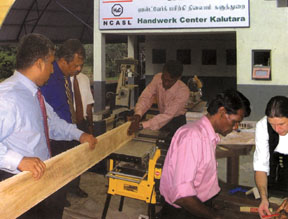|
observer |
|
|
|
|
|
OTHER LINKS |

|

|

|
Construction industry to counter acute shortage of skilled labourThe construction industry is making a valiant attempt to fight the acute shortage of skilled labour, which is holding back economic development. Foreign technical assistance and funds are also being obtained, and some measures have been implemented.
The manpower of skilled labour required for the building construction from 2005 to 2008 is estimated to exceed 150 million labour days, a resource study carried out by the Department of Building Economics of the University of Moratuwa says. Adding to the shortage of skilled manpower in the aftermath of the tsunami destruction two years ago, which has thrown in an enormous load of construction work, yet, to be undertaken, general secretary, Chamber of Construction Industry, of Sri Lanka (CCISL) Dakshitha Thalgodapitiya said. The enhanced building activities for the proposed construction of Sri Lanka's tallest building of 49 storeys, entails foreign direct investment surpassing $600 million, compared to the total FDI of $275 million in 2005. This will more than double the demand for skilled labour in the building sector, Prof Chitra Weddikkara, dean, Faculty of Architecture and Planning, University of Moratuwa said. For the road development programs identified as public investment for the period 2006 - 2011 - the skilled work required would exceed 75 million man days, the study says. CCISL's multiple strategy are designed to provide 25,000 trained craftsmen for the construction industry. The Samurdhi Authority will also be called in to collaborate in setting up training centres to train Samurdhi beneficiaries. As part of the move, CCISL will operate construction craftsmen training centres in association with the Bioforce Development Institute of France, in the districts of Galle, Matara, Hambantota, Gampaha and in Ampara to produce 520 craftsmen per centre initially for a two-year period, where trainees will be paid a daily stipend of Rs 300. Such training centres will be endorsed by TVEC and will follow TVEC curricular and accreditation processes, eventually conforming to the NVQ framework, Thalgodapitiya said. CCISL will enter into a tripartite agreement with TVEC and the relevant vocational training providers to undertake construction craftsmen training by managing training designated centres and by meeting stipends to trainees and incentives for trainers with funds raised by the chamber. In another manoeuvre towards countering the dearth of skilled manpower, the Federation of Chambers of Commerce and Industry of Sri Lanka (FCCISL) and the National Construction Association of Sri Lanka (NCASL) have linked with Germany's Chamber of Crafts (Handwerkskammer) Koblenz to set up vocational training centres in tsunami affected districts. A Handwerk Centre has been set up in the Kalutara district, with financial assistance from the Netherlands, German government, Hadwerkskammer Koblenz and the German State of Rheinland-Pfalz. The centre counts over 6,000 square feet and provides a fully equipped workshop for masonry, carpentry, welding, airconditioning, plumbing, electrical wiring and painting. Trainees will reside in the centre during the training period, director of the centre, Malinda Moonesinghe said. Prof Weddikkara appealed to the media to persuade young people to overlook the current norm of shunning the construction industry. To counter such social perception, the Handwerk Centre will present certificates calling masons building craftsmen, carpenters - building woodwork craftsman, plumber - sanitary installation craftsman and the like of tiling craftsmen, steel fabrication craftsmen, air-conditioning craftsmen and industrial electrician. The centre employs qualified trainers and has access to German technical experts, the head of which is Tobias Allmoslochner, who claimed descent from a family tree of carpenters. The standards of training are on near par with the German Standards and the certificates issued are jointly issued by the Handwerk Centre, Handwerkskammer Koblenz and TVEC, Allmoslochner said. Construction companies are requested to contact this centre through FCCISL. The benefits of Handwerk Centre are: higher quality of workmanship; reduction of waste; workers need less supervision and understand work given to them; trained workers will do work faster and be innovative. |









